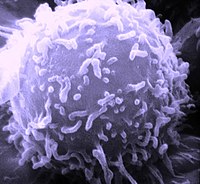
Photo from wikipedia
Background Children are less susceptible than adults to symptomatic COVID‐19 infection, but very few studies addressed their underlying cause. Moreover, very few studies analyzed why children highly exposed to the… Click to show full abstract
Background Children are less susceptible than adults to symptomatic COVID‐19 infection, but very few studies addressed their underlying cause. Moreover, very few studies analyzed why children highly exposed to the virus remain uninfected. Methods We analyzed the serum levels of ACE2, angiotensin II, anti-spike and anti-N antibodies, cytokine profiles, and virus neutralization in a cohort of children at high risk of viral exposure, cohabiting with infected close relatives during the lockdown in Spain. Results We analyzed 40 children who were highly exposed to the virus since they lived with severe acute respiratory syndrome coronavirus-2 (SARS-CoV-2)-infected relatives during the lockdown for several months without taking preventive measures. Of those, 26 reported mild or very mild symptoms. The induced immune response to the virus was analyzed 3 months after the household infection. Surprisingly, only 15 children had IgG anti-S (IgG+) determined by a sensitive method indicative of a past infection. The rest, negative for IgG anti-N or S in various tests, could be further subdivided, according to IgM antibodies, into those having IgM anti-S and IgM anti-N (IgG−IgMhigh) and those having only IgM anti-N (IgG−IgMlow). Interestingly, those two subgroups of children with IgM antibodies have strikingly different patterns of cytokines. The IgMhigh group had significantly higher IFN-α2 and IFN-γ levels as well as IL-10 and GM-CSF than the IgMlow group. In contrast, the IgMlow group had low levels of ACE2 in the serum. Both groups have a weaker but significant capacity to neutralize the virus in the serum than the IgG+ group. Two children were negative in all immunological antibody tests. Conclusions A significant proportion of children highly exposed to SARS-CoV-2 did not develop a classical adaptive immune response, defined by the production of IgG, despite being in close contact with infected relatives. A large proportion of those children show immunological signs compatible with innate immune responses (as secretion of natural antibodies and cytokines), and others displayed very low levels of the viral receptor ACE2 that may have protected them from the virus spreading in the body despite high and constant viral exposure.
Journal Title: Frontiers in Immunology
Year Published: 2023
Link to full text (if available)
Share on Social Media: Sign Up to like & get
recommendations!